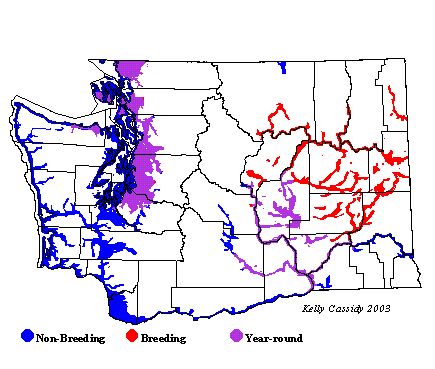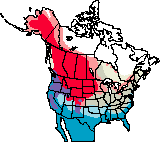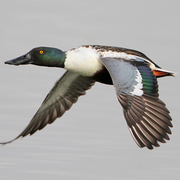Northern Shoveler
General Description
The very large, spatulate bill is the most distinguishing feature of the aptly named Northern Shoveler. The male in breeding plumage has bright wings, a bright iridescent-green head with a yellow eye, bold white breast, and chestnut sides. Females, juveniles, and males in eclipse plumage (from May through August) are mottled brown with orange legs and a green-black iridescent speculum with a blue patch on the forewing.
Habitat
Northern Shovelers inhabit shallow, marshy ponds and wetlands at low elevations. Breeding habitat is in open country (prairie or tundra), or lowland woodlands and clearings, always near shallow water. During winter and migration they will use virtually any wetland as long as it has muddy edges. Shovelers will forage in sewage ponds and stagnant or polluted waters avoided by other species of ducks.
Behavior
Northern Shovelers rarely tip up, but filter mud through their bills, swimming with their heads outstretched, bills skimming the water's surface, sifting out food. In flight they stay in tight bunches, weaving to and fro like shorebirds. Shovelers are the most territorial of all the North American dabblers, and pair bonds remain intact through incubation, unlike most other species of ducks.
Diet
The bill of the Shoveler is ideally suited for straining small swimming invertebrates from the water and mud. Seeds and aquatic plants are also important food items, especially during winter.
Nesting
Pair formation begins in the winter and continues during spring migration. Males remain with the females through the incubation period. The female chooses the site (generally in short grass). She builds the nest, a shallow depression made of grass and weeds, lined with down, and incubates the 9 to 12 eggs for 23 to 28 days by herself. A few hours after they hatch, the female leads the young to the water where they can swim and forage immediately. The young typically stay close to the cover of emergent vegetation, and the female tends them until they fledge at 52 to 66 days of age.
Migration Status
Northern Shovelers migrate in flocks in a prolonged migration period in both the spring and the fall. The spring migration is relatively late, usually peaking about the end of April. The fall migration begins in August, peaks in September, and continues into November. Many Northern Shovelers winter in Washington.
Conservation Status
Due to their highly specialized bills and consequent habitat requirements, the Northern Shoveler appears to be less affected by drought and food scarcity than other dabblers. This may explain how this species has maintained long-term stable populations.
When and Where to Find in Washington
The Northern Shoveler is a common breeder throughout Washington's lowland ponds and wetlands (although some birds sighted in summer on the west side of the Cascades are non-breeders). It is also a common winter resident. Northern Shovelers are more common breeders on the east side of the Cascades than on the west side, but more common wintering on the west side in appropriate habitat.
 Abundance
Abundance
| Ecoregion | Jan | Feb | Mar | Apr | May | Jun | Jul | Aug | Sep | Oct | Nov | Dec |
|---|---|---|---|---|---|---|---|---|---|---|---|---|
| Oceanic | ||||||||||||
| Pacific Northwest Coast | F | F | F | C | U | R | R | U | U | F | F | F |
| Puget Trough | C | C | C | C | C | F | F | F | C | C | C | C |
| North Cascades | R | R | R | R | R | R | R | R | R | |||
| West Cascades | C | C | C | C | U | U | U | U | F | C | C | C |
| East Cascades | R | R | U | U | U | U | U | U | R | R | ||
| Okanogan | U | C | C | C | C | C | C | C | C | C | ||
| Canadian Rockies | F | F | F | F | F | F | F | |||||
| Blue Mountains | U | U | R | U | R | |||||||
| Columbia Plateau | C | C | C | C | C | F | F | F | C | C | C | C |
Washington Range Map

North American Range Map


Family Members
 Fulvous Whistling-DuckDendrocygna bicolor
Fulvous Whistling-DuckDendrocygna bicolor Taiga Bean-GooseAnser fabalis
Taiga Bean-GooseAnser fabalis Greater White-fronted GooseAnser albifrons
Greater White-fronted GooseAnser albifrons Emperor GooseChen canagica
Emperor GooseChen canagica Snow GooseChen caerulescens
Snow GooseChen caerulescens Ross's GooseChen rossii
Ross's GooseChen rossii BrantBranta bernicla
BrantBranta bernicla Cackling GooseBranta hutchinsii
Cackling GooseBranta hutchinsii Canada GooseBranta canadensis
Canada GooseBranta canadensis Mute SwanCygnus olor
Mute SwanCygnus olor Trumpeter SwanCygnus buccinator
Trumpeter SwanCygnus buccinator Tundra SwanCygnus columbianus
Tundra SwanCygnus columbianus Wood DuckAix sponsa
Wood DuckAix sponsa GadwallAnas strepera
GadwallAnas strepera Falcated DuckAnas falcata
Falcated DuckAnas falcata Eurasian WigeonAnas penelope
Eurasian WigeonAnas penelope American WigeonAnas americana
American WigeonAnas americana American Black DuckAnas rubripes
American Black DuckAnas rubripes MallardAnas platyrhynchos
MallardAnas platyrhynchos Blue-winged TealAnas discors
Blue-winged TealAnas discors Cinnamon TealAnas cyanoptera
Cinnamon TealAnas cyanoptera Northern ShovelerAnas clypeata
Northern ShovelerAnas clypeata Northern PintailAnas acuta
Northern PintailAnas acuta GarganeyAnas querquedula
GarganeyAnas querquedula Baikal TealAnas formosa
Baikal TealAnas formosa Green-winged TealAnas crecca
Green-winged TealAnas crecca CanvasbackAythya valisineria
CanvasbackAythya valisineria RedheadAythya americana
RedheadAythya americana Ring-necked DuckAythya collaris
Ring-necked DuckAythya collaris Tufted DuckAythya fuligula
Tufted DuckAythya fuligula Greater ScaupAythya marila
Greater ScaupAythya marila Lesser ScaupAythya affinis
Lesser ScaupAythya affinis Steller's EiderPolysticta stelleri
Steller's EiderPolysticta stelleri King EiderSomateria spectabilis
King EiderSomateria spectabilis Common EiderSomateria mollissima
Common EiderSomateria mollissima Harlequin DuckHistrionicus histrionicus
Harlequin DuckHistrionicus histrionicus Surf ScoterMelanitta perspicillata
Surf ScoterMelanitta perspicillata White-winged ScoterMelanitta fusca
White-winged ScoterMelanitta fusca Black ScoterMelanitta nigra
Black ScoterMelanitta nigra Long-tailed DuckClangula hyemalis
Long-tailed DuckClangula hyemalis BuffleheadBucephala albeola
BuffleheadBucephala albeola Common GoldeneyeBucephala clangula
Common GoldeneyeBucephala clangula Barrow's GoldeneyeBucephala islandica
Barrow's GoldeneyeBucephala islandica SmewMergellus albellus
SmewMergellus albellus Hooded MerganserLophodytes cucullatus
Hooded MerganserLophodytes cucullatus Common MerganserMergus merganser
Common MerganserMergus merganser Red-breasted MerganserMergus serrator
Red-breasted MerganserMergus serrator Ruddy DuckOxyura jamaicensis
Ruddy DuckOxyura jamaicensis

